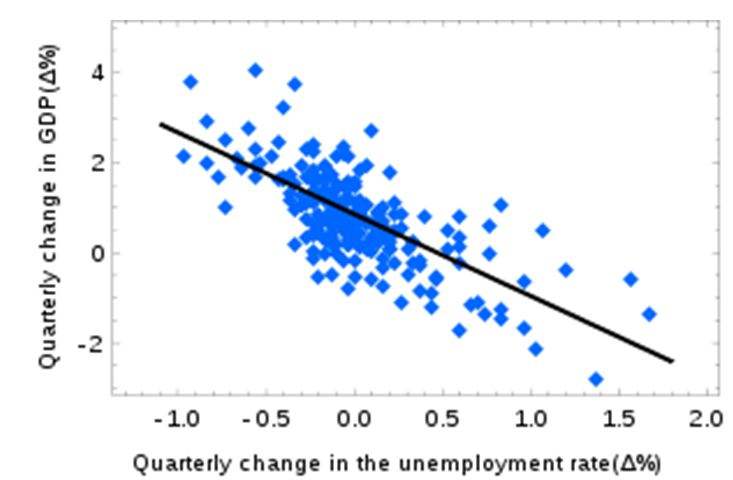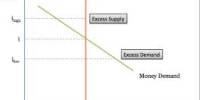Okuns Law
What Does Okun’s Law Mean? The relationship between an economy’s unemployment rate and its gross national product (GNP). Twentieth-century economist Arthur Okun developed this idea, which states that when unemployment falls by 1%, GNP rises by 3%. However, the law only holds true for the U.S. economy, and only applies when the unemployment rate falls between 3-7.5%. Other version of Okun’s Law focus on a relationship between unemployment and GDP, whereby a percentage increase in unemployment causes a 2% fall in GDP.

Graph of US quarterly data (not annualized) from 1947 through 2002 estimates a form of the difference version of Okun’s law: %Change GNP = .856 – 1.827*(Change Unemployment Rate). R^2 of .504. Differences from other results are partly due to the use of quarterly data. In economics, Okun’s law is an empirically observed relationship relating unemployment to losses in a country’s production first quantified by Arthur M. Okun. The “gap version” states that for every 1% increase in the unemployment rate, a country’s GDP will be at an additional roughly 2% lower than its potential GDP. The “difference version” [1] describes the relationship between quarterly changes in unemployment and quarterly changes in real GDP. The accuracy of the law has been disputed. The name refers to economist Arthur Okun who proposed the relationship in 1962.
Imperfect relationship Okun’s law is more accurately called “Okun’s rule of thumb” because it is primarily an empirical observation rather than a result derived from theory. Okun’s law is approximate because factors other than employment (such as productivity) affect output. In Okun’s original statement of his law, a 3% increase in output corresponds to a 1% decline in the rate of unemployment; a .5% increase in labor force participation; a .5% increase in hours worked per employee; and a 1 % increase in output per hours worked (labor productivity).[3] Okun’s law states that a one point increase in the unemployment rate is associated with two percentage points of negative growth in real GDP. The relationship varies depending on the country and time period under consideration. The relationship has been tested by regressing GDP or GNP growth on change in the unemployment rate. Martin Prachowny estimated about a 3% decrease in output for every 1% increase in the unemployment rate (Prachowny 1993). The magnitude of the decrease seems to be declining over time in the United States. According to Andrew Abel and Ben Bernanke, estimates based on data from more recent years give about a 2% decrease in output for every 1% increase in unemployment (Abel and Bernanke, 2005). There are several reasons why GDP may increase or decrease more rapidly than unemployment decreases or increases. As unemployment increases,
- a reduction in the multiplier effect created by the circulation of money from employees
- unemployed persons may drop out of the labor force (stop seeking work), after which they are no longer counted in unemployment statistics
- employed workers may work shorter hours
- labor productivity may decrease, perhaps because employers retain more workers than they need
One implication of Okun’s law is that an increase in labor productivity or an increase in the size of the labor force can mean that real net output grows without net unemployment rates falling (the phenomenon of “jobless growth”). As a relationship between changes in the unemployment rate and economic growth, Okun’s law predicts that growth slowdowns typically coincide with rising unemployment. The recent experience of 2006 shows, however, that this is not always the case. This article has documented several reasons for this. First among these is that Okun’s law is not a tight relationship. There have been many exceptions to Okun’s law or instances where growth slowdowns have not coincided with rising unemployment. This is true when looking over both long and short time periods. This is a reminder that Okun’s law—contrary to connotations of the word “law”—is only a rule of thumb, not a structural feature of the economy. This article has also documented that Okun’s law has not been a stable relationship over time. Part of this variation is related to the state of the business cycle: The relationship between output and unemployment is different in recessions and expansions, and recent expansions have been longer than average. Additionally, the data suggest that a weakening of the contemporaneous relationship between output and unemployment has coincided with a stronger relationship between past output growth and current unemployment.
















